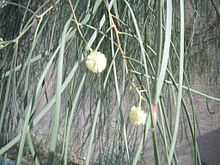Acacia stenophylla
| Acacia stenophylla | |
|---|---|
 | |
| Scientific classification | |
| Kingdom: | Plantae |
| (unranked): | Angiosperms |
| (unranked): | Eudicots |
| (unranked): | Rosids |
| Order: | Fabales |
| Family: | Fabaceae |
| Genus: | Acacia |
| Species: | A. stenophylla |
| Binomial name | |
| Acacia stenophylla | |
| Synonyms | |
Acacia stenophylla, the Shoestring acacia, is an evergreen tree in the family Fabaceae native to Australia
Description
Acacia stenophylla is a fast-growing tree, that grows to 4–10 metres (13–33 ft) tall.[2] The form is upright with decumbent or weeping branches and foliage. The leaves are gray to gray-green, narrow and long.
Acacia stenophylla has medium salt and frost tolerance. The average minimum annual rainfall that the tree needs is around 400mm/yr.[2] It is not listed as a threatened species.[1]
Common names
Common names used in Australia include:
- Balkura, Belalie, Black Wattle, Dalby Myall, Dalby Wattle, Dunthy, Eumong, Gooralee, Gurley, Ironwood, Munumula, Native Willow, River Cooba, River Cooba, and River Myall.[1]
Uses
The plant is said to contain medicinal alkaloids.[3]
Acacia stenophylla is widely planted as a drought tolerant and decumbent ornamental tree. It is cultivated by plant nurseries, and used in modernist gardens and in public landscapes in the Southwestern United States and California.
Gallery
-

Acacia stenophylla - Form
-

Acacia stenophylla - Bark
-

Acacia stenophylla - with Seed Pods
References
| Wikimedia Commons has media related to Acacia stenophylla. |
External links
- CSIRO Csiro.au: Acacia stenophylla - Australian publication